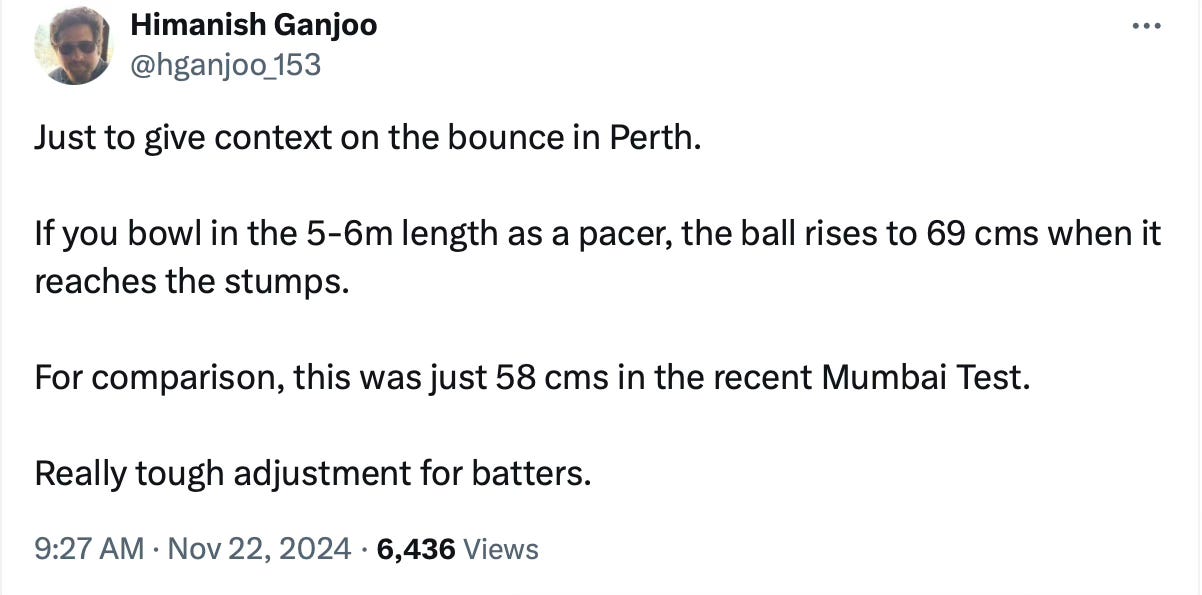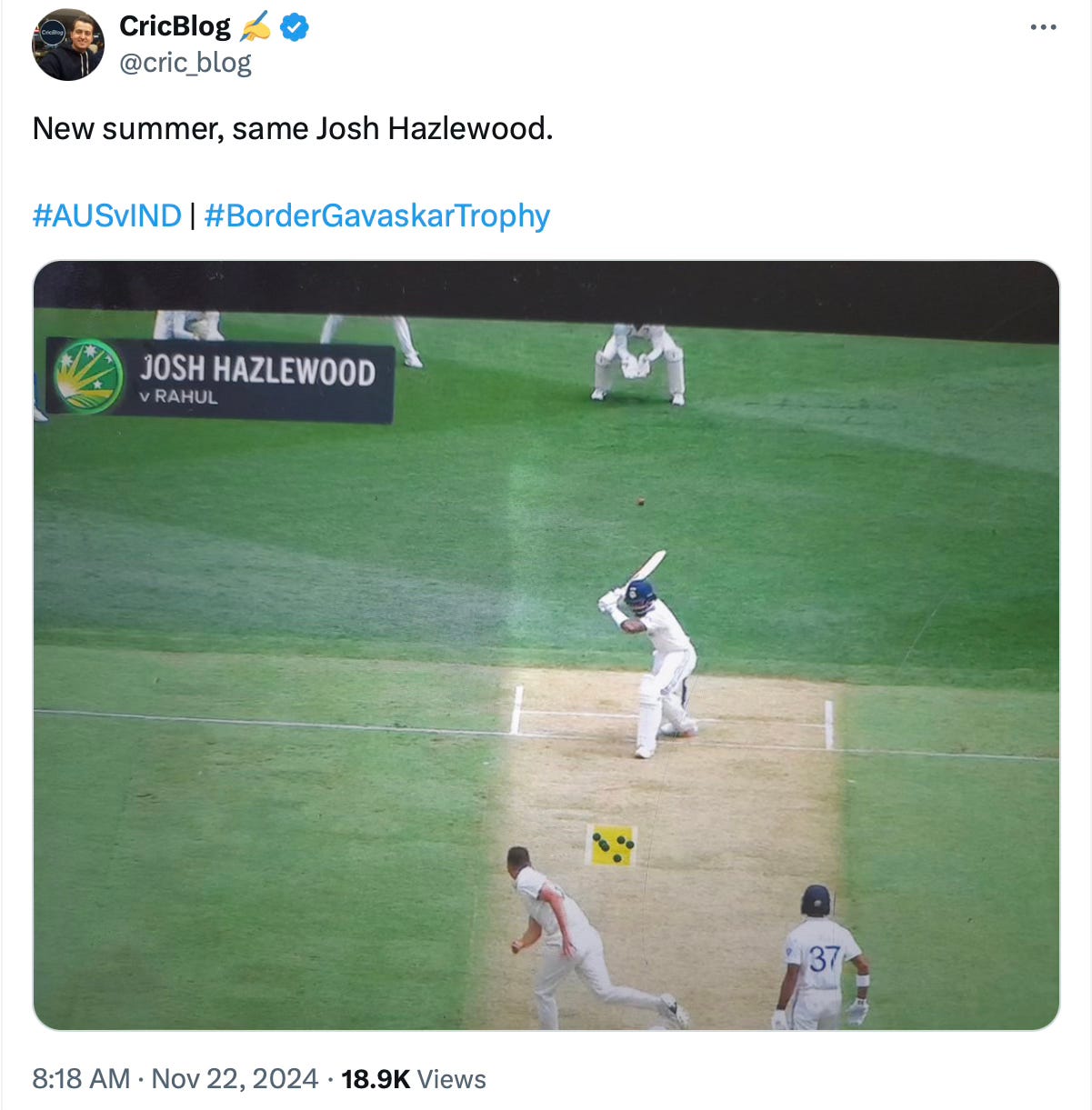Bumrah's will & application from openers allow India to edge past the hosts
On the back of better conditions, Indian openers fought hard to put India comfortably ahead at the end of Day 2.
India were coming off a shock 0-3 loss to New Zealand at home. Injuries and unavailability meant only 5 players in the Indian squad had visited Australian shores (with the senior team) more than once. Imagine playing on a pitch that bounces 11 cms more (on average) from the same length as the previous pitch.
Even for professionals, making adjustments to their technique so quickly (most players had just one intra-squad game) is very challenging. Add to that, they were going to face the quartet of Starc-Hazlewood-Cummins-Lyon at home, who were just short of 500 test wickets together in 30 matches.
It was never going to be easy for the visitors.
Visiting teams are used to pinpoint accuracy of Josh Hazlewood and Pat Cummins, while Mitch Starc troubles them with pace, seam and the left-arm angle. As the ball gets older, Nathan Lyon comes in with overspin and extra bounce. None of this is a surprise to any visiting team, but dealing with it is another matter.
Barring Lyon (who didn’t really get a go), Australia did predictibly just that and left India reeling 4 down for just 50 at lunch.
In recent times, fans have lamented (mostly inaccurately) that India’s batting has suffered due to emphasis on limited-overs cricket and batting with intent. Indian batter on Day 1 (with the exception of Pant), showed tremendous patience. At 3, Devdutt Padikkal played 20+ balls with patience before being dismissed for 0. KL Rahul batted a long while before getting a dodgy decision and Virat Kohli got undone with some extra bounce. Majority of the dismissals were caught behind the wicket or in the slip/gully region, and no batter was dismissed trying a wild shot.
While credit must go to the Australian attack, the curator decision to leave about 10mm of grass on the pitch certainly played a part. There’s little doubt that was one of the toughest batting pitch ever produced in Australia. The average seam movement on Day 1 was 0.8 degrees, highest ever for this stadium. In fact, certain balls like debutant Harshit Rana’s jaffa to dismiss Travis Head moved way more, 1.35 degrees.
The other debutant, Nitish Kumar Reddy, made a vital 41 top-scoring for India and allowing them to get to a total of 150 at Tea. Fans of previous generations had seen older Indian teams getting mauled down under multiple times (like in 1999 and 2011). They knew the bowlers, led by stand-in skipper Jasprit Bumrah, would have to be on the money to ensure Australians didn’t run away with it.
The only people Bumrah disappointed were the Australians.
Apart from a couple of easy singles conceded to Khawaja on his pads early on, Bumrah found the perfect line and length to trouble the Australian top four. In his 1st stint as captain, Bumrah out-willed the opposition by smacking a 16-ball 31 in 2022, today he was determined to make the most of just 150 on board. Within his first 24 balls, Bumrah produced not 1, not 2 but 4 wicket taking deliveries. Continuing his brilliance against Khawaja and Labuschange, Bumrah also cleaned-up Steve Smith for his 2nd golden duck in Test cricket. Smith was out LBW to his characteristic back and across shuffle, surely this was plotted by the Indians after looking at some of his recent dismissals.
On the previous tour, former Indian coaches Ravi Shastri and Bharat Arun plotted to minimize the off-side play of Australian batters. It felt like that strategy was still in play versus Labuschange as he defended more than 50 balls, majority on this stumps, to be dismissed for just 2 runs. Siraj put Labuschange out of misery as Australia ended the day at 67/7.
On day 2, Hazlewood and Starc frustrated the Indians with the bat but India managed to dismiss them with a lead of 46. In conditions this extreme, a couple of ordinary sessions or pitch easing out a little can completely the match. So 46 is a handy lead, but it was still anyone’s game. Even WinViz showed India had a 54% chance when the visitors were 30/0 in the 2nd innings.
When the Indian openers came out to bat in the 2nd innings, they had to apply themselves. The hosts did beat their bat and get the occasional edge, but KL Rahul and Jaiswal batted with soft hands (something Pujara mastered over the years) and ensured the edges didn’t carry to the slip cordon. The pitch wasn’t as deadly as Day 1, but it still had some juice. Both openers showed great discipline. Jaiswal was out to an attempted drive in the 1st innings, he didn’t try to hit a full-bloodied drive until the 57th ball he played. Such adjustment in such a short period is quite commendable.
KL Rahul continued his fine form from Day 1. He played within his limits and maintained a control % of nearly 90. Without a doubt, Rahul’s been the standout batter in this test and deserves to add to 7 overseas test hundreds. The Australians didn’t bowl badly in the 2nd innings. In fact, they kept things tight for the most part. After tea, the hosts put the breaks on the scoring and kept the duo to just 26 runs in the first 20 overs.
Until that point, the 2nd session on Day 2 was the only time when batters were able to score over 3 an over consistently. In the last hour, Jaiswal took some risks and changed that. He scored 31 off 37 balls putting India firmly in front to end the day (effectively) 218 runs ahead without the loss of any wicket. With the odd balls staying low, there’s enough in the pitch to keep the bowlers interested and India will know that anything over 300 will be very tough to chase in the 4th innings.
17 wickets fell in 77 overs on Day 1 of this test match. In the sub-continent, the media would have jumped to the narrative of “doctored pitches”, but we heard none of that from any mainstream channels. None of this - the way pitches are in focus in the subcontinent versus in background in Australia / NZ / England / South Africa - is new, however, the quality of bowling and tough pitches don’t paint a complete picture.
Greg Blewett’s comment on air is an important one to keep in mind. Just like a different batch of duke balls used during the summer of 2022 changed the dynamics of the matches played in England, the changes to the Kookaburra ball has made batting substantially tougher in Australia.
With ball tracking data and all types of advanced analytics, there is plenty of evidence to suggest that this is the hardest era to bat in Australia in a long time. All of this - the pitches, quality of fast bowling, and the changed Kookaburra ball - has created a perfect storm for the Australian batters. The likes of Smith and Labuschange, who were making truckloads of runs in the past, have slowed down to average mid-30s since 2023. Even in domestic cricket, not a lot of top order batters are scoring runs, that’s why - Nathan McSweeney was given a debut as an opener despite scoring majority of his first class runs at 4 and 5.
It’s very interesting that both sets of batters in this match have had very similar fortunes in recent times. An opener in each side (Khwaja and Rohit) had 3 solid years but has had a recent drop in form. The main star of the batting line-ups (Smith and Kohli) is little past their prime and finding it hard with tougher conditions around the world. Others (Labuschange and KL Rahul) haven’t shown the consistency that’s expected for their talents.
My initial prediction for this series was 4-1 to Australia. While that might still likely hold, if the Aussies continue to produce pitches like one and Jasprit Bumrah manages to stay fit for all 5 tests, India might have a better chance. In such testing batting conditions, lower order runs and having solid 3rd and 4th bowlers, who keep things in check, when the main bowlers are resting will become crucial. India’s will likely play Ashwin or Jadeja in some tests, but the 4th and 5th bowlers will still be weaker links. Whether my gut feeling turns out to be true or not, it’s certain to be a cracker of series.






